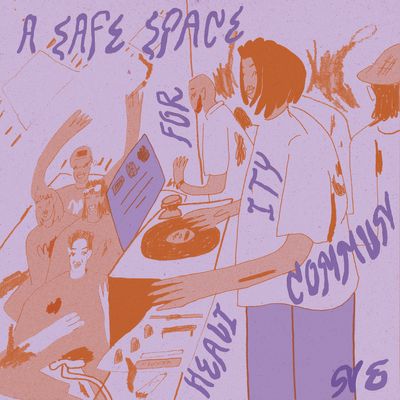
Psychedelics are hardly strangers to party dance floors, but it wasn’t until earlier in this pandemic, when L.A. lifted its first lockdown, that I was invited to my first ’shroom party. The garden soirée, billed as a “safe space for community healing,” was hosted by a couple from L.A.’s underground music scene in their backyard. Hand-drawn tea bags stuffed with ’shrooms sat on tables next to joints rolled with rose petals. As stylish guests, many young and queer people of color, sat socially distanced on picnic blankets, sipping ’shroom teas and nibbling olive bread against a glowing sunset, a deep sense of serenity settled over the scene. I wondered: Is this the future?
COVID-19 has cleared the arena for America’s druggiest era, as the twin wrecking balls of economic devastation and psychic trauma leave a crater of suffering — and drugs come to fill the void. Welcome to the dissociation generation, baby! In this dawning new age, doctors prescribe party drugs, politicians push weed legalization as historic budget deficits loom, and everyone is tripping balls in the name of self-care. Maybe snorting your therapy sounded silly until the pandemic pushed our sanity to the brink; in quarantine, 13.3 percent of American adults started using substances or ramped up existing habits. My friends in New York have picked up ketamine like a cozy new hobby akin to knitting.
Yet as America’s War on Drugs wanes, its legacy remains, as people of color sit behind bars on drug convictions while white executives reap the gains. In fact, the racial gap for pot arrests is climbing up in California even as the number of arrests drop. Further, the abject social conditions that breed drug abuse — mental illness, homelessness, and uh, the overwhelming alienation of late-stage capitalism — are also metastasizing at the same moment states are loosening restrictions, meaning the end of prohibition is flying in the face of skyrocketing overdoses and addiction. So a paradox arises: Can drugs be both a symptom of, and solution to, our collective misery?
Perhaps the skeleton key lies in a paradigm prioritizing healing over hedonism. Drugs like LSD and MDMA have long histories with psychotherapy and were used to treat everything from alcoholism to marital problems (MDMA until 1985 when it became classified as a drug without current medical use, and LSD until Nixon signed the Controlled Substances Act in 1970). Now, psychedelic therapy is roaring back: Oregon’s legal psilocybin therapy clinics will open in 2023 — the same year the FDA is expected to approve MDMA for therapeutic use, according to MAPS, the organization backing the clinical trials. Soon, maybe you’ll visit your local psychedelic clinic for post-COVID trauma and grab a ketamine lollipop on your way out. Or book a stay at a ketamine resort in Colorado or weed hotel in Arizona for your next family trip (Mom would really love that).
Meanwhile, as tripping turns chic, the underground psychedelic scene is going luxe. Over the last few months, I’ve seen dozens of illicit ’shroom and acid brands in California package their products with stylish labels, embossed fonts, and pastel millennial colorways. Dealers hawk trendy ’shroom strains over Signal (right now, it’s a particularly potent variety called Penis Envy), and microdosing brands host chat rooms on Clubhouse. DMT vapes are the new status symbols (Juuling is so over), and gold-flaked ’shroom chocolates are paired with champagne. Competitors differentiate themselves by offering curation and convenience. Think: tasteful cans of nootropic-enhanced cocktails for the “Cali Sober” set, and “spore-to-door” delivery kits for growing ’shrooms at home. The other day, a company in Peru even sent my friend in Los Angeles a vacuum-sealed bag of mail-order ayahuasca.
So many questions remain for the post-COVID drug bonanza: Who is going to get access to these therapeutic substances — and who will be allowed to administer them? Clearly, our future providers will hail from Silicon Valley and Big Pharma, as VC-backed biomedical companies race to reap the psychedelic landscape and mark their territories with patents. Sci-fi devices like ’shroom nasal sprays and wearable ketamine patches glimmer in the near horizon, but the hoops for FDA approval are high, so don’t get too excited: These devices may ultimately be nothing more than biomedical pipe dreams. Even if a psychedelic clinic opens in your neighborhood, will treatment be covered by insurance or remain prohibitively expensive to most? Underlying these unknowns are more fundamental questions: Should all drugs be decriminalized — or are psychedelics an exception? Are drugs and the pursuit of pleasure an unalienable right — or a privilege for a few?
A few weeks after the ’shroom party, I wondered if my drug prognostications had been incomplete. A guy I was flirting with at an outdoor strip club confessed he was addicted to fentanyl, a synthetic opiate 50 times stronger than heroin. While fentanyl users tend to either inject or smoke it out of a pipe, he dropped the white rocks into a glass dab rig, then lit a blowtorch to vaporize the sweet-smelling stuff for the most potent possible hit. His high-tech opiate addiction butted against my sunny optimism toward the psychedelic-therapy renaissance. I thought: This feels like the future too.
More From This Series
- Wild Speculation: A Series About What Comes Next
- Where Will Skin Care Go From Here?
- What Will Be Cool This Summer?




